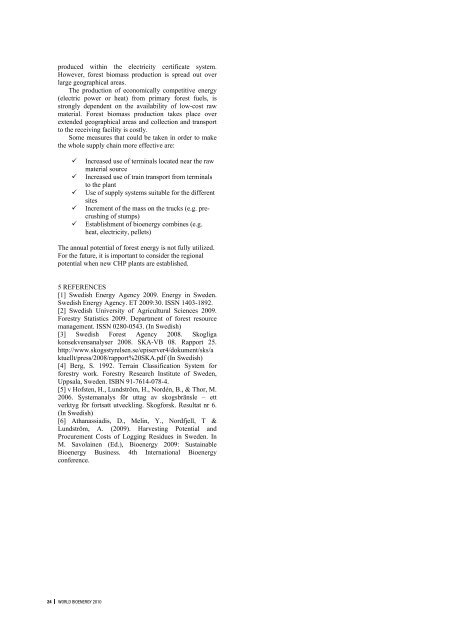Proceedings World Bioenergy 2010
Proceedings World Bioenergy 2010
Proceedings World Bioenergy 2010
Create successful ePaper yourself
Turn your PDF publications into a flip-book with our unique Google optimized e-Paper software.
produced within the electricity certificate system.<br />
However, forest biomass production is spread out over<br />
large geographical areas.<br />
The production of economically competitive energy<br />
(electric power or heat) from primary forest fuels, is<br />
strongly dependent on the availability of low-cost raw<br />
material. Forest biomass production takes place over<br />
extended geographical areas and collection and transport<br />
to the receiving facility is costly.<br />
Some measures that could be taken in order to make<br />
the whole supply chain more effective are:<br />
� Increased use of terminals located near the raw<br />
material source<br />
� Increased use of train transport from terminals<br />
to the plant<br />
� Use of supply systems suitable for the different<br />
sites<br />
� Increment of the mass on the trucks (e.g. precrushing<br />
of stumps)<br />
� Establishment of bioenergy combines (e.g.<br />
heat, electricity, pellets)<br />
The annual potential of forest energy is not fully utilized.<br />
For the future, it is important to consider the regional<br />
potential when new CHP plants are established.<br />
5 REFERENCES<br />
[1] Swedish Energy Agency 2009. Energy in Sweden.<br />
Swedish Energy Agency. ET 2009:30. ISSN 1403-1892.<br />
[2] Swedish University of Agricultural Sciences 2009.<br />
Forestry Statistics 2009. Department of forest resource<br />
management. ISSN 0280-0543. (In Swedish)<br />
[3] Swedish Forest Agency 2008. Skogliga<br />
konsekvensanalyser 2008. SKA-VB 08. Rapport 25.<br />
http://www.skogsstyrelsen.se/episerver4/dokument/sks/a<br />
ktuellt/press/2008/rapport%20SKA.pdf (In Swedish)<br />
[4] Berg, S. 1992. Terrain Classification System for<br />
forestry work. Forestry Research Institute of Sweden,<br />
Uppsala, Sweden. ISBN 91-7614-078-4.<br />
[5] v Hofsten, H., Lundström, H., Nordén, B., & Thor, M.<br />
2006. Systemanalys för uttag av skogsbränsle – ett<br />
verktyg för fortsatt utveckling. Skogforsk. Resultat nr 6.<br />
(In Swedish)<br />
[6] Athanassiadis, D., Melin, Y., Nordfjell, T &<br />
Lundström, A. (2009). Harvesting Potential and<br />
Procurement Costs of Logging Residues in Sweden. In<br />
M. Savolainen (Ed.), <strong>Bioenergy</strong> 2009: Sustainable<br />
<strong>Bioenergy</strong> Business. 4th International <strong>Bioenergy</strong><br />
conference.<br />
24 world bioenergy <strong>2010</strong>









